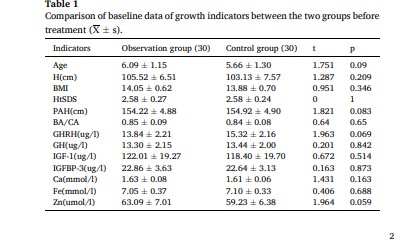For 6 years old, who have more deformable bones. However, it is possible that strengthening the stimulus could make it worker for older and even skeletally mature individuals. If stretching works via articular cartilage endochondral ossification.
Exercise combined with lysine-inositol vitamin B12 promotes height growth in children with idiopathic short stature
Short stature is short stature of an unknown cause(not familial or genetic or unknown genetic origin). One of these causes could be inadequate nutrition including B12 deficiency. So using idiopathic short stature individuals is not ideal. The ideal test subjects would be normal stature individuals. Then ideally you’d try to find a way to reproduce the results in skeletally mature individuals by strengthening the stimulus.
“Researchers observed that many patients with ISS whose genetic target height is around the 50th percentile have no symptoms, and their bone age was only slightly lower than the age in the auxiliary examination. For these children, regular exercise of moderate intensity was employed. Stretching exercise, combined with oral lysine-inositol vitamin B12 (VB12), can effectively promote height growth. Based on
this, we systematically observed the clinical efficacy of regular stretch exercise of moderate-intensity combined with lysine and VB12 oral liquid in the intervention of ISS.”<-One possibility to make this paper work on the skeletally mature is to increase the intensity of the stretching exercise. It is possible that the exercise may work by increasing nutrient uptake in the growth plate in which case it won’t work in the skeletally mature.
“A total of 60 children with ISS who met the inclusion criteria and were treated at the traditional Chinese medicine dwarfism clinic of the Henan Children’s Hospital from June 2018 to July 2020 were selected.”
“The observation group consisted of 23 males and 7 females, aged 4.33–8.33 years. The control group consisted of 22 males and 8 females, aged 4.00–7.92 years.”

“(1) age < 3 years, or age > 10 years (male) or age > 8 years (female); (2) not meeting the ISS diagnostic criteria; (3) height growth rate ≥ 5 cm per year; (4) family history of hereditary diseases or underlying diseases of the heart, liver, kidney, etc.; (5) mental or emotional disorders or history of malnutrition.”<-it’s good that they removed malnutrition but that does not rule out vitamin deficiencies.
“The control group was given oral lysine-inositol VB12 oral solution (10 mL bid). Meanwhile, the observation group was given oral lysine-inositol VB12 oral solution (10 mL bid) and exercised according to the “ISS exercise guidance sheet”, which was developed in terms of exercise items, exercise intensity, exercise time, exercise days per week and so on. The children were instructed to perform aerobic exercises, such as brisk walking, running, jumping rope, etc., followed by stretching activities.”<-so really no unusual exercise activities
“The exercise could be broken down into two or three sessions per day to prevent children from
being overworked. Both groups were undergoing treatment for 12 months.”
“after 6 and 12 months of treatment, GV, serum GHRH, GH, IGF-1, and IGFBP-3 levels in the observation group were significantly higher than those in the control group whereas its HtSDS[Height Standard Deviation Score] was significantly lower than that in the control group{there was less height variance in the exercised group}. The difference between the two groups was statistically significant); after 12 months of treatment, Height in the observation group was significantly higher than that in the control group, and the difference between the two groups was statistically significant“
“The micronutrient Zn has been reported to promote growth rate in children with dwarfism.”
“Lysine VB12 is a complex of lysine, inositol, and VB12 that can be used to treat lysine deficiency symptoms, such as lack of appetite and poor growth. Lysine is an essential amino acid for all proteins in the human body and is a precursor substance for peptide hormones and coenzymes. In addition to maintaining metabolic balance in the body, lysine is an essential substance for children’s growth and development, since it can improve immune function, promote intellectual and physical development, improve nutritional status, and increase appetite”

So height is greater in the exercised group but so is starting height which is not ideal but still this is promising but this really needs follow up studies.

So interesting stuff here but we need more studies to see how it could play out. What would be interesting is spreading out the exercise more throughout the day to see if that reduce the negative correlation between minutes per day and growth velocity. Watching follow up studies will be helpful. Also we want to really optimize the optimal exercises. And find a way for any of the exercises to potentially work on adults.




